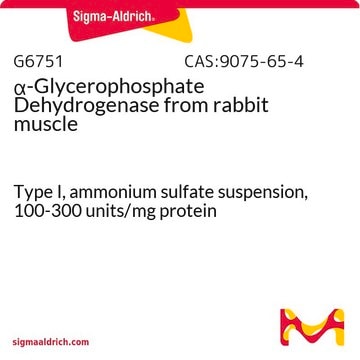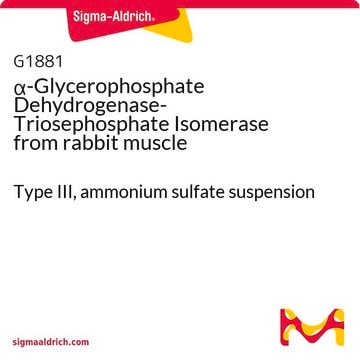G6880
α-Glycerophosphate Dehydrogenase from rabbit muscle
Type X, lyophilized powder, ≥100 units/mg protein
Synonym(s):
sn-Glycerol-3-phosphate Dehydrogenase from rabbit muscle, sn-Glycerol-3-phosphate:NAD+ 2-oxidoreductase
About This Item
Recommended Products
type
Type X
Quality Level
form
lyophilized powder
specific activity
≥100 units/mg protein
composition
Protein, ≥75%
foreign activity
Lactic dehydrogenase, pyruvate kinase, aldolase, and glyceraldehyde-3-phosphate dehydrogenase ≤0.01%
Triosephosphate isomerase ≤0.02%
shipped in
wet ice
storage temp.
−20°C
Looking for similar products? Visit Product Comparison Guide
Related Categories
Application
Biochem/physiol Actions
Unit Definition
Physical form
Analysis Note
Signal Word
Danger
Hazard Statements
Precautionary Statements
Hazard Classifications
Resp. Sens. 1
Storage Class Code
11 - Combustible Solids
WGK
WGK 1
Flash Point(F)
Not applicable
Flash Point(C)
Not applicable
Certificates of Analysis (COA)
Search for Certificates of Analysis (COA) by entering the products Lot/Batch Number. Lot and Batch Numbers can be found on a product’s label following the words ‘Lot’ or ‘Batch’.
Already Own This Product?
Find documentation for the products that you have recently purchased in the Document Library.
Customers Also Viewed
Our team of scientists has experience in all areas of research including Life Science, Material Science, Chemical Synthesis, Chromatography, Analytical and many others.
Contact Technical Service











